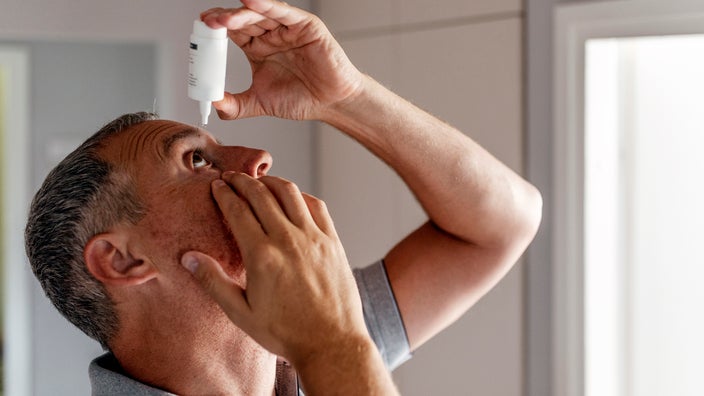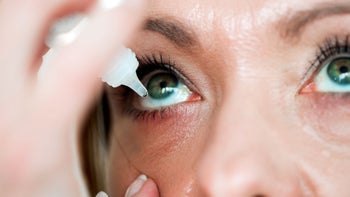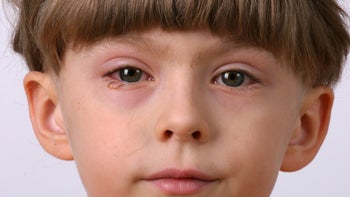
Can You Use Expired Eye Drops? Learn the Risks
Key takeaways:
It’s never recommended to use expired eye drops. That’s because they can become less effective or contaminated over time.
Opened bottles of eye drops are more likely to become contaminated. Experts recommend replacing open eye drops after 1 month unless the packaging or directions state otherwise. Preservative-free drops are only safe for a single use.
You can help keep your eye drops safe by using and storing them properly. Reach out to your healthcare team for guidance.

Eye drops are used for many eye-related medical conditions. Some eye drops contain antibiotics to treat an infection, while others help regulate eye pressure or provide relief from dry eye. You can find certain products over the counter (OTC). Others require a prescription.
But do eye drops expire? If you haven't cleaned out your medicine cabinet recently, you may wonder if they’re still OK to use. In this article, we'll review what you should know about expired eye drops. We’ll also discuss how to determine if they’re safe to use.
Is it safe to use expired eye drops?
No. As with any medication that’s expired, you shouldn’t use eye drops after the expiration date on the bottle. This is true whether the bottle is opened or unopened.
Search and compare options
Eye drops should remain effective and safe until the labeled expiration date, as long as they’re stored correctly. But after they’re expired, eye drops are one of the riskier types of medication to use. Since they’re typically in a liquid or gel form, eye drops are more likely to break down and become contaminated than solid dosage forms (e.g., pills). This is especially true once the bottle is opened.
If you're unsure whether your eye drops are still effective and safe, check with your prescriber or pharmacist before using them. They can help you determine if they’re safe to use.
What happens to eye drops after you open them?
Two things happen after you open eye drops. The first is that the active ingredient(s) can start to break down. This means that over time, the eye drops may become less effective.
The second thing that happens is that germs can enter the product. This is because opening the bottle breaks the sterile seal. The sterile seal helps protect the drops from being contaminated. For this reason, it’s best to wait until you need to use the eye drops before opening a new bottle.
Many eye drops contain preservatives, which help prevent the growth of bacteria and lower the risk of infection. These are usually multiuse eye drop bottles. Eye drops can also come as single-use vials, which don’t have preservatives. These single-use vials shouldn’t be used more than 24 hours after opening, in most cases.
How long do eye drops last after you open them?
Most experts agree that you should throw away eye drops within 1 month after opening the bottle, unless the packaging or directions say otherwise. After that, the preservatives inside can break down, which allows bacteria to grow.
Struggling with dry eyes? Learn about the best eye drops and home remedies to treat dry eye.
Treating dry eye safely: Artificial tears can provide fast relief, but they can cause problems if used too often. Here’s how long you can safely use them.
Artificial tears vs. eye drops: Over-the-counter products can help relieve dry or red eyes. Experts explain the difference between artificial tears and eye drops, and when to use each product.
If you're unsure when you opened a bottle of eye drops or can’t read the expiration date, it's best to avoid using them. Throw it away and pick up a new bottle, or contact your pharmacy for further guidance if they’re prescription eye drops.
Each type of medicated eye drops may have different instructions for how long you can use it after it’s opened. Generally, you should expect that the eye drops will be stable long enough to finish your treatment. But you should always read the pharmacy instructions or package information and follow it carefully. And don’t hold onto leftover eye drops once your treatment course is finished, unless your prescriber tells you to do so.
Let’s take a look at some common examples.
Read more like this
Explore these related articles, suggested for readers like you.
Antibiotic eye drops
If you’re using antibiotic eye drops, the duration of treatment is usually 14 days or less. In most cases, the bottle should be stable for your full treatment course. But you shouldn’t save any leftover antibiotic eye drops for later use, even if they’re still good after your treatment is finished. They don’t all work for the same infections, and it could be harmful to use the wrong antibiotic. See a healthcare professional for a new prescription every time an eye infection happens, unless they tell you otherwise.
Examples of antibiotic eye drops include:
Moxifloxacin (Vigamox)
Ciprofloxacin (Ciloxan)
Azithromycin (AzaSite)
Tobramycin (Tobrex)
If you’re using antibiotic eye drops long term, your healthcare team will let you know how long each bottle is usable once it’s opened.
Good to know: Amoxicillin doesn’t come in eye drops form. But oral amoxicillin liquid suspension also expires after 14 days once it’s mixed. That’s because, as with eye drops, oral liquids break down quickly and are more susceptible to contamination than pills.
Glaucoma eye drops
There are several types of prescription eye drops that treat glaucoma. In most cases, these are drops you’ll use every day. So it’s typically fine to keep using an opened bottle until it’s empty before opening a new one, as long as the expiration date hasn’t passed. Examples of glaucoma eye drops include:
Latanoprost (Xalatan)
Timolol (Timoptic)
Brimonidine (Alphagan P)
Netarsudil (Rhopressa)
Dorzolamide / timolol (Cosopt)
Keep in mind that some eye drops for glaucoma require refrigeration for long-term storage. They often expire sooner if they’re kept at room temperature. So be sure to follow the storage directions carefully.
Single-use drops for dry eye
Several types of eye drops come in single-use vials. Each vial has enough medication for a single dose in each eye and should be thrown away immediately after use. It isn’t safe to keep a single-use vial for later use once it’s been opened.
Examples of single-use eye drops products include:
Lifitegrast (Xiidra)
Cyclosporine (Restasis)
Refresh Plus (carboxymethylcellulose sodium) and other OTC lubricant eye drops
Keep in mind that it’s best to see a healthcare professional if you need OTC dry eye drops for more than 3 days in a row. Chronic dry eye can be a sign of something more serious, so it shouldn’t be managed on your own long term.
Why do some types of eye drops expire sooner than others?
As mentioned above, certain eye drops expire sooner than others because of how they’re made. Eye drops that contain preservatives are designed to last longer. Eye drops designed for single use don’t contain preservatives. So they’re more likely to become contaminated and aren’t safe to use more than once.
The manufacturers of each type of eye drops must also conduct stability testing. This helps determine how long it stays safe and effective, which contributes to the expiration date. Different active ingredients are more or less stable than others. This means expiration dates can vary between products.
Does saline solution expire?
Yes. Saline solutions for contact lenses have an expiration date, just like other eye drops. The expiration date will be printed on the label, bottle, or box. Once the bottle is open, experts recommend discarding it after 90 days, unless the label says otherwise. Preservative-free saline solution should be thrown away within 24 hours of opening it.
What happens if you use expired eye drops?
The risks of using expired eye drops include:
Loss of product effectiveness, or worsening of eye condition: Expired eye drops may not work as well as they should. This can leave your eye condition untreated or undertreated, or even allow it to worsen. In severe cases, this could affect your vision or have other long-term consequences.
Increased risk of infection: The longer an eye drops container is open, the more risk there is for contamination. If you use contaminated eye drops, you may introduce germs into your eyes. This can lead to an eye infection, on top of the eye condition you’re using the drops to treat.
It isn’t worth the risk to use expired eye drops. When in doubt, discard expired eye drops and replace them with a fresh bottle. This recommendation may seem frustrating, especially since eye drops can be costly. But avoiding expired eye drops is the safer choice and may even help you save money from complications in the long run.
If you accidentally use expired eye drops, reach out to your prescriber or pharmacist for guidance. If you experience any bothersome effects, such as irritation or pain, it’s best to seek medical care right away.
How can you keep eye drops from becoming contaminated and help them last?
There are several steps you can take to keep your eye drops safe until the expiration date:
Know how to administer them correctly. You can help prevent contamination by washing your hands before and after using your eye drops. It’s also very important to avoid touching the tip of the bottle to your eye, eyelid, or fingers.
Store your eye drops properly. Keep your eye drops in a dry location at the recommended temperature. Some eye drops should be stored at room temperature. Others should be stored in the refrigerator. Avoid spaces that become hot or damp, such as the bathroom medicine cabinet.
Write down the date you open your eye drops. This can help you keep track of how long the bottle has been open and discard it at the right time.
Only open one bottle of eye drops at a time. Sometimes, you may get a 90-day supply of eye drops that contains several bottles. Keep the bottles you aren’t using sealed and stored properly until the current one is used up or expired.
Go through your medications quarterly. This includes both OTC and prescription medications. Discard expired medications or products you no longer need or use. This helps lower the chance you’ll use an expired product by mistake.
If you’re unsure how to use or store your eye drops, turn to your healthcare team for guidance.
The bottom line
It’s best to avoid using expired eye drops. Unopened eye drops are good until the expiration date if they’re properly stored. But once they’re opened, you should discard eye drops within 1 month unless the package or directions state otherwise. Preservative-free eye drops in single-use vials should be thrown away within 24 hours after opening.
Using expired eye drops raises your risk of eye infection. It can also leave your eye condition untreated, as your eye drops can lose effectiveness after they’re expired. If you can’t read the expiration date or aren’t sure when you opened your eye drops, it’s best to replace them.
You can help keep eye drops safe by storing and administering them properly. Reach out to your healthcare team for guidance if needed.
Why trust our experts?



References
Allergan, Inc. (2022). Refresh Plus- carboxymethylcellulose sodium solution/ drops [package insert]. DailyMed.
American Academy of Allergy, Asthma, & Immunology. (2010). Tips for administering eye drops.
American Academy of Allergy, Asthma, & Immunology. (2020). Eye drops.
American Optometric Association. (n.d.). Contact lens care.
Beery, S., et al. (2019). Can medications become harmful after the expiration date? Nursing2024.
Chaudhary, O. R. (2022). How long can you use prescription eye drops after opening them? American Academy of Ophthalmology.
Geyer, O., et al. (1995). Microbial contamination of medications used to treat glaucoma. British Journal of Ophthalmology.
Gikonyo, D., et al. (2019). Drug expiry debate: The myth and the reality. African Health Sciences.
Iskandar, K., et al. (2022). Highlighting the microbial contamination of the dropper tip and cap of in-use eye drops, the associated contributory factors, and the risk of infection: A past-30-years literature review. Pharmaceutics.
Mwangi, N., et al. (2023). Empowering patients to manage their eye medication at home. Community Eye Health Journal.
U.S. Department of Health and Human Services, et al. (2023). Quality considerations for topical ophthalmic drug products: Guidance for industry. U.S. Food and Drug Administration.
Walsh, K., et al. (2019). The use of preservatives in dry eye drops. Clinical Ophthalmology.





























